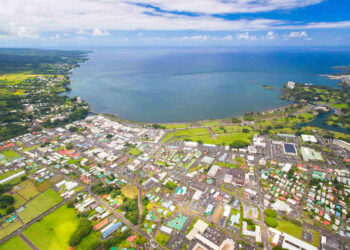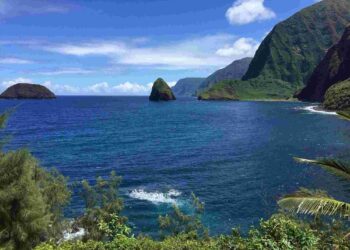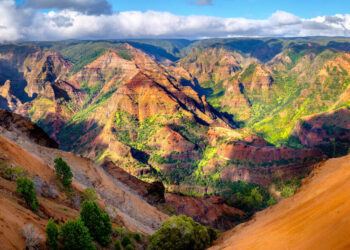Perched on the southeastern edge of the Big Island of Hawai‘i, Hawai‘i Volcanoes National Park is a geological wonderland that captures the very raw and elemental power of nature.
Home to two of the world’s most active volcanoes, Kīlauea and Mauna Loa, the park is a changing landscape where the earth is continuously shaped by fire along with time. The park covers a total area of 300,000 acres, enclosing everything from lush green rainforests and volcanic deserts to ancient lava tubes and steaming calderas(Large depressions formed when a volcano erupts and collapses). This forever-changing land offers a unique opportunity to the visitors to witness the birth of land, as the lava flow and carve their way through the island and into the sea. The park is like a living museum of geology and an awesome spiritual site for Native Hawaiians, offering a unique blend of natural and cultural heritage.
History of Hawai‘i Volcanoes National Park
The story of Hawai‘i Volcanoes National Park is deeply interrelated to the Hawaiian mythology and native traditions. According to the Hawaiian legend, the National park’s central figure is Pele, the fiery goddess of volcanoes, who is believed to reside in Halemaʻumaʻu Crater at the summit of Kīlauea. Her presence is felt by the people throughout the landscape, in the sound of the steam vents, the glow of molten lava, and the black rock that tells the story of uncountable eruptions. The land here is very sacred, and in fact, many locals come to offer prayers and gifts to Pele. The cultural significance of the park is great, and many ancient trails, and archaeological sites within its borders tell the story of the Hawaiian people’s deep connection to the volcanic landscape. As you walk through the park, you’re not just exploring nature but you’re stepping into a living tale of creation and reverence.
Places to visit in Hawai‘i Volcanoes National Park
1) Kīlauea
Kīlauea, which is one of the most active volcanoes on Earth, has always been fascinating for both the scientists and the travelers. The eruptions occurring there have shaped most of the Big Island’s southeastern coastline and still continue to redefine the landscape. The 2018 eruption was one of the most powerful in recent history, which destroyed hundreds of homes and changed the overall structure of the park itself. Today, visitors can safely explore parts of the lava flows, including areas where the ground is still warm to the touch. The Kīlauea Visitor Center offers valuable and unique insights into still going volcanic activity, safety information, and historical context, making it a great first stop on your journey through the park. Scientists from around the world study Kīlauea’s behavior to better understand volcanic activity and its impact on ecosystems and communities.
2) Mauna Loa
Another awe-inspiring and very unique feature of the park is Mauna Loa, which is the largest volcano on Earth by volume. Although less active than Kīlauea, its sheer size covers most of the island’s landscape, and its summit rises over 33,500 feet from the ocean floor, making it taller than Mount Everest if measured from base to peak. Hiking to the very summit of Mauna Loa is a very challenging task, only applicable for the most prepared adventurers, but shorter trails on its lower slopes still offer proper view of this massive volcano in its entirety. Along the way, you’ll find surreal vistas of hardened lava fields, native plant species, and vast expanses that feel almost otherworldly. Whether shrouded in mist or basking in sunlight, Mauna Loa’s quiet power is unforgettable.
3) Thurston Lava Tube (Nāhuku)
The visit to Hawai‘i Volcanoes National Park is not complete without a walk through the Thurston Lava Tube (Nāhuku), a massive cave-like tunnel formed by flowing lava centuries ago. The short trail of the park goes through a dense rainforest then descends into the dark, damp lava tube, providing a unique contrast between life above ground and the boiling lava that sculpted the earth below. Other famous sites include the Devastation Trail, formed during Kīlauea’s 1959 eruption, and the Crater Rim Drive, a scenic road that circles the summit caldera with dramatic overlooks and steam vents. For those visitors, who venture out after dark, the night glow of the Halemaʻumaʻu crater when active is truly a sight to behold that stays long in memory, with the red-orange light reflecting the volcano’s fiery image.
The ecological diversity within Hawai‘i Volcanoes National Park is very impressive and quire diverse as much as its geological features. The park covers a wide range of elevations ranging from sea level to over 13,000 feet which creates a variety of distinct ecosystems. Visitors, they can walk through the green rainforests filled with native ʻōhiʻa trees and rare birds like the ‘apapane and ‘i‘iwi, and then just a short drive away, they can find barren lava fields where hardly anything grows. This contrast of life and desolation is part of what makes the park so captivating. Endemic species, which cannot be found anywhere else on Earth, thrive here, though many are quite under the threat from invasive species and habitat loss. Conservation efforts are ongoing, and the park is a key site for ecological research and species protection.
Conclusion
Hawai‘i Volcanoes National Park is more than just a natural attraction, it’s a sacred landscape of fire, mythology, and resilience. It doesn’t matter whether you’re a hiker, a science enthusiast, or a spiritual seeker, the park offers a deeply intimate experience that connects you to the forces of the nature and earth that formed not just Hawai‘i, but the entire planet. The trails have footprints of the humans and lava, but they also do echo with the stories of gods, nature’s fury, and human frailty. It’s a place that truly humbles and inspires, reminding all visitors who visit that the Earth is alive, powerful, and always in motion.











